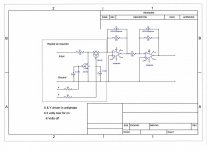Much better to use MOSFET (like a 2SK152 etc).
LDR's are not ideal... to big, poorly matched. I have no idea what the capacitance is end to end when off but imagine it's pretty large.
Hard to say when it's "not audible" as even a simple switch provides enough stray capacitance that the audio can be heard more often than not.
As I say, my preferred option is small MOSFET's in a series shunt arrangement. Give as near total isolation as you could wish.
Do you need an optically isolated switch (control to switch) ?
LDR's are not ideal... to big, poorly matched. I have no idea what the capacitance is end to end when off but imagine it's pretty large.
Hard to say when it's "not audible" as even a simple switch provides enough stray capacitance that the audio can be heard more often than not.
As I say, my preferred option is small MOSFET's in a series shunt arrangement. Give as near total isolation as you could wish.
Do you need an optically isolated switch (control to switch) ?
I doub't I'll need a switch to begin with but it's a thought that's been nagging me.
It's one of those things I just have to figure out just for the heck of it.
Still I think you're right, transistor circuit is probably better. I'm hopless when it comes to active cirquit designs so I tend to fall back on passive stuff.
It's one of those things I just have to figure out just for the heck of it.
Still I think you're right, transistor circuit is probably better. I'm hopless when it comes to active cirquit designs so I tend to fall back on passive stuff.
Depends what you are after, and the circuit surrounding it.
I use MOSFET as here, and feeding a virtual earth amp eliminates crosstalk between inputs. The FET's see no signal voltage across them when on which minimises linearity issues.
Even just the single series pass FET is 99% of the way there, adding the shunt FET that gives total isolation.
I use MOSFET as here, and feeding a virtual earth amp eliminates crosstalk between inputs. The FET's see no signal voltage across them when on which minimises linearity issues.
Even just the single series pass FET is 99% of the way there, adding the shunt FET that gives total isolation.
Attachments
The first thing that jumps out are the op-ams in the signal path and that alone disqualifies the circuit in my book.
Sure there are op-amps in cdp's, dacs and active filters and no one complains but givenhe choice I'd rather do without them.
But back to the original question.
How much attenuation is considered quiet?
Cranking up my preamp today results in cleary audiable music even if the channel switch is set to something completely different.
Sure there are op-amps in cdp's, dacs and active filters and no one complains but givenhe choice I'd rather do without them.
But back to the original question.
How much attenuation is considered quiet?
Cranking up my preamp today results in cleary audiable music even if the channel switch is set to something completely different.
The first thing that jumps out are the op-ams in the signal path and that alone disqualifies the circuit in my book.
Forgetting the OpAmps, the series shunt arrangement is as near perfect as you could wish. The on resistance of the 2SK152 is around 30 ohms when driven correctly. The off resistance is "whatever FET's are when off" lol Many millions of meg ohms anyway. The only breakthrough with a single FET is caused by junction capacitance and any stray board capacitance.
When you add the second "shunt" FET, well that just kills completely any remaining breakthrough.
How good in real terms... well you can apply something crazy like a 15 volt squarewave at any frequency and turn the volume up on full with ears in the speaker... silence.
But back to the original question.
How much attenuation is considered quiet?
Cranking up my preamp today results in cleary audiable music even if the channel switch is set to something completely different.
The fact you hear audible breakthrough shows the isolation or physical design is poor. Much commercial gear fails on this point to.
How much is audible... good question. Also most breakthrough varies with frequency due to capacitive coupling effects, so perfect isolation at DC or LF doesn't mean much... it has to apply throughout the audio band.
I would guess your 120db isn't so far off the mark.
Hiss in tweeter is audible (noise with no signal). If that were 0.1mv in amplitude referenced to say 28 volts RMS from a 100 watt amp, then thats
around a 109db... and you need to go lower tha that.
Why not rig a pot up, say 10 k and feed the top end with audio via a 1meg ? or 10 meg ? resistor and see yourself at what level you begin to hear audio.
Then measure the ratios and work it out roughly. Work that out at DC, imagine applying 10 volts to the top end and calculate the output on the pot wiper... rough and ready but might be interesting.
- Status
- This old topic is closed. If you want to reopen this topic, contact a moderator using the "Report Post" button.
- Home
- Source & Line
- Analog Line Level
- LDR Switch?
